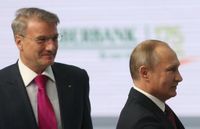Warnings of recession and economic turmoil are echoing across the globe as leading financial experts and policymakers raise red flags about the world’s largest economies. From Washington to Moscow, the specter of debt, political interference, and war-driven instability is shaking confidence in the future of global growth.
In the United States, the debate over fiscal health has reached a fever pitch. On September 4, 2025, Ray Dalio, founder of Bridgewater Associates and one of America’s most respected investors, sounded the alarm in an interview with the Financial Times. Dalio warned that the U.S. economy is on the verge of a “debt-induced heart attack,” a crisis he believes could strike within three years if current fiscal policies continue. His concern centers on the Trump administration’s approach to debt and monetary policy, which he says relies on the “dangerous assumption” that the U.S. can keep borrowing without consequence. “Excessive borrowing and rising interest costs” are, according to Dalio, creating a precarious situation that could rapidly unravel if investor confidence slips.
Dalio’s warning isn’t just theoretical. The U.S. national debt has soared to a staggering $37.3 trillion, with more than $1 trillion now spent annually just on interest payments—an amount that eats up 17% of the federal budget, according to Fortune. The Trump administration’s signature legislative proposal, the One Big Beautiful Bill Act (OBBBA), promises sweeping tax cuts for working- and middle-class Americans. However, the Congressional Budget Office estimates that the OBBBA could add $3.4 trillion to the national debt, a figure only partially offset by expected revenues from tariffs. Even with those tariffs, the U.S. is far from covering its ballooning debt servicing costs, which hit $60.95 billion in July alone.
Complicating matters further is the growing political pressure on the Federal Reserve. President Trump has openly criticized Fed Chair Jerome Powell for maintaining high interest rates and has even attempted to remove Fed Governor Lisa Cook over allegations of mortgage fraud. The Fed, for its part, has held firm, keeping interest rates at 4.25% to 4.5% despite Trump’s push for aggressive rate cuts. The central bank’s caution reflects ongoing concerns about inflation and the potential for Trump’s tariff-heavy policies to further stoke price increases.
Europe is watching closely. On September 1, 2025, European Central Bank President Christine Lagarde told BBC that any political interference with the Fed could undermine its independence and destabilize the global economic order. “The Fed’s independence is crucial for maintaining economic stability, not just in the U.S. but globally,” Lagarde warned, adding that the politicization of American monetary policy represents “a very serious danger.” Financial leaders have echoed these concerns, with JPMorgan Chase CEO Jamie Dimon warning that undermining the Fed could erode confidence in the dollar and disrupt global markets.
The financial markets have already begun to react. Government bond yields in the U.S., UK, and France have climbed as investors worry about fiscal policy, economic uncertainty, and political instability. The risks of unchecked debt accumulation and the potential for spillover effects from U.S. policy decisions are now top of mind for global investors.
Meanwhile, the U.S. economy faces mounting signs of strain. Mark Zandi, chief economist at Moody’s, has been one of the loudest voices warning of an impending recession. On September 4, 2025, Zandi told Newsweek, “I don’t think the economy is in a recession, at least not at this point, but it feels like it’s on the brink, it’s on the precipice of this recession.” The August jobs report, released September 5, is seen as a crucial test, with Zandi expecting a modest 50,000 payroll job increase and a jump in the unemployment rate to 4.3%. He also predicted that job gains reported in June and July would be revised downward, possibly revealing actual job losses—a development that would spark a “legitimate debate over whether the economy is already in a recession.”
Job opening data released on September 3 painted a bleak picture, showing just 7.18 million listings in July, the lowest level since the pandemic. These numbers have only fueled anxiety about the trajectory of the recovery. Zandi, who famously predicted the 2008 financial crisis, has steadily raised his odds of a recession throughout 2025—from 15% at the year’s start to 40% by March 30. By late August, he reported that nearly a third of U.S. states are either already in or at high risk of recession, with another third merely holding steady. “States experiencing recessions are spread across the country, but the broader DC area stands out due to government job cuts,” Zandi noted, while emphasizing that the relative stability of California and New York remains crucial for the national economy.
Adding to the uncertainty is President Trump’s nomination of Heritage Foundation economist E.J. Antoni to head the Bureau of Labor Statistics. The move has sparked concerns among economists that the traditionally nonpartisan agency could become politicized, undermining trust in vital economic indicators. Dave Hebert, an economist at the conservative American Institute for Economic Research, commented, “I’ve been on several programs with him at this point and have been impressed by two things: his inability to understand basic economics and the speed with which he’s gone MAGA.” Jessica Riedl, a senior fellow at the Manhattan Institute, added, “The articles and tweets I’ve seen him publish are probably the most error-filled of any think tank economist right now.”
On Wall Street, the mood is equally anxious. UBS, after examining data from May through July, put the odds of a U.S. recession at 93%—a level described as “historically worrying.”
The economic storm isn’t confined to the U.S. Russia, too, is grappling with stagnation and the threat of recession. On September 4, 2025, German Gref, CEO of Sberbank and a close ally of President Vladimir Putin, told reporters at the Eastern Economic Forum in Vladivostok that Russia’s wartime economy is now in “technical stagnation” and that urgent measures are needed to avoid a downturn. Russia’s Central Bank has kept its key interest rate at a historically high 18% (down from 21%) in an effort to curb inflation, which stands at 8.8%. But business leaders argue that these high rates are choking investment and worsening the economy’s woes.
Despite official growth figures of 4.1% in 2023 and 4.3% in 2024, Russia’s growth is slowing dramatically. Finance Minister Anton Siluanov recently told Putin that growth is likely to fall to just 1.5% in 2025, well below the previously forecasted 2.5%. Gref warned, “Reviving the economy will be much more difficult than cooling it down…at current inflation levels, the rate at which we can hope for economic recovery is 12 percent or lower.”
Yet some experts, such as Richard Portes of the London Business School, say that even drastic rate cuts won’t be enough to fix Russia’s deeper problems. “I think the Russian economy is in a very bad state, and it’s not going to get better…the problems of the Russian economy are not due to high central bank interest rates,” Portes told Newsweek. He points instead to labor shortages, war-related disruptions, and a shift from consumer to defense production as the true culprits.
As the Russian Central Bank prepares for its next meeting on September 12, the world will be watching closely to see what steps—if any—can stave off a deeper crisis.
With the U.S. and Russia both facing mounting risks, the global economic outlook appears more uncertain than ever. The coming months will test whether policymakers can navigate these turbulent waters without triggering a broader financial storm.

